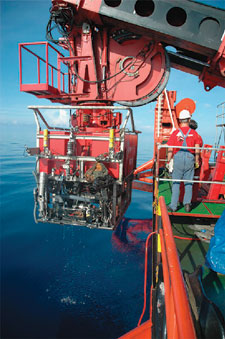What's new in exploration
Seafloor riches. Does anyone remember the Jennifer Project of 1974? It was supposed to be a science mission to mine manganese nodules from the seafloor, 750 mi northwest of Hawaii. In fact, as we all now know, it was a CIA (Intelligence Agency) cover story. The Glomar Explorer was trying to raise a sunken Soviet nuclear submarine in 17,000 ft of water. I’ll bet a few of you were on that mission. Manganese nodules were first discovered in 1868 in the Arctic Ocean off Siberia during a scientific expedition of the H.M.S. Challenger. After a burst of popularity in the early 1970s, thanks mostly to the CIA story, manganese nodules began fading from the headlines. But they recently raised their dense, knobby little heads. For the uninitiated, manganese nodules – also called polymetallic nodules – are dark, often smooth, pellet-to-baseball sized rocks that lie on the seafloor. They are metal-rich and form in layers around a “seed” core, which could be just about anything (a piece of shell, tooth, pebble). Their principal commercial elements are manganese (~27%), copper (~1%), nickel (~1%), and perhaps most importantly, cobalt (~0.25%). They occur in all oceans, even lakes, at any depth, but the highest concentrations have been found on vast abyssal plains in the deep ocean, between 13,000 and 20,000 ft. They grow at a rate of a few millimeters per million years. The most promising commercial deposits occur in a 500-mi-wide belt in the eastern equatorial Pacific, between Hawaii and Central America. Nearly $500 million has been spent on research and development of seabed resources over the last 30 years. In the mid-1970s, a $70 million international joint venture succeeded in collecting tons of nodules from 18,000-ft depths in the eastern equatorial Pacific Ocean. But none achieved commercial success.
These nodules grow from at least five processes, some of which may operate concurrently. These include the precipitation of metals from seawater, diagenetic remobilization of manganese in the water column, hydrothermal deposition of metals from hot springs/ volcanic activity, the decomposition of basaltic debris by seawater (halmyrolitic ) and the biogenic precipitation of metal hydroxides via microorganisms. According to an article in Hydro International, a deepwater system is being developed in Germany for mining these nodules. Bulk carriers would shuttle between mining ships and shore processing plants. The operation is predicted to be capable of mining 300,000 tons of raw material per year. The metals produced from just one such operation could equal 50% of present manganese production and provide all of the world’s cobalt needs. But there’s another realm of seafloor riches. One or more of the processes that form nodules – hydrothermal vents and perhaps biological processes – also form metal-rich crusts, some of which are at much shallower depths. And some of those crusts have up to 10 times as much cobalt as nodules, and are rich in gold and silver as well. Discovered in the late 1970s, these sulfur-rich ore bodies are called polymetallic sulfide crusts. They are formed by processes similar to black smokers and are associated with volcanic hot spots. Oilfield technology has paved the way for the world’s first seafloor mining companies to take the plunge. Neptune Minerals has secured rights to territorial waters off the north coast of New Zealand’s North Island, and is assessing deposits there. Nautilus Minerals and partner, Placer Dome, are sampling a deposit in an area that it leased off the eastern coast of Papua New Guinea. International laws governing nodule mining have been worked out over the last six years or so. Mining of polymetallic sulfide crusts still has some legal and environmental issues to work out, but there appear to be no show stoppers, since there are reasonable people on both sides involved. Besides, given that these are industrial metals that must be supplied, a case could be made that the seafloor is the lower environmental impact route compared to mining on land. For both types of resources, the key questions are: How are these seafloor resources best explored for, and exploited with, modern technology? You can bet that the answers to these questions will involve seafloor bathymetry, shallow seismic, AUVs, ROVs, DP drillships and the expertise to operate these tools. In fact, that’s already the case. Many of us are aware that the hard-mineral folks at professional societies sometimes feel overlooked by their oilier brethren. So, this becomes another place for employment for G&G types. In the near future, some of the ingredients in the pipe in your well will have probably come from the seafloor. The ocean mining industry is just getting started, and its future seems assured. Noteworthy discoveries. Back in the oil patch, Total made its fifth discovery in Block 32, offshore Angola. The Mostarda 1 well tested 5,347 bpd of 30° API oil. Marathon (30%), Sonagol (20%) Esso (15%) and Petrogal (5%) are its partners. Repsol YPF found its seventh new field in Libya’s NC186 concession, with Well K1. The well flowed 2,300 bopd. This brings the preliminary reserves total to 500 million for the seven discoveries. Partners are the National Oil Corp., Libya (60%), Hydro (8%), Total (9.6%) and OMV (9.6%). Stuart Petroleum struck oil in Cooper basin, Australia, with its wildcat, Toparoa 1. The well tested 1,814 bpd of 42° API oil. Partner Avery Resources holds a 35% stake.
|
|||||||||||





